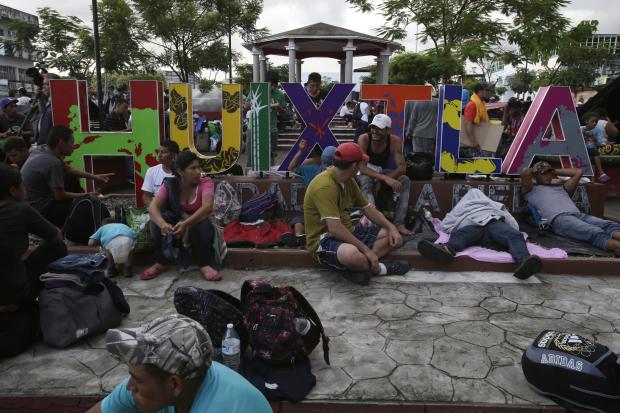
Central American migrants making their way to the U.S. rest in a park after arriving to Huixtla, Mexico, Monday, Oct. 22, 2018. Thousands of Central American migrants resumed an arduous trek toward the U.S. border Monday, with many bristling at suggestions there could be terrorists among them and saying the caravan is being used for political ends by U.S. President Donald Trump. (Photo by MOISES CASTILLO / AP)
HUIXTLA, Mexico — Thousands of Central American migrants awoke Tuesday in a makeshift encampment in a rain-soaked town square in far-southern Mexico, some weary, foot-sore and coughing, still distant from their goal of reaching the U.S. border.
The caravan, estimated to include more than 7,000 people, had advanced about 45 miles (75 kilometers) since crossing the border from Guatemala, and still faced more than 1,000 miles, and likely much further, to the end of the journey.
But as the sun rose, a chorus of coughs arose from the shapeless forms wrapped in blankets and bits of plastic sheeting. Burned by the relentless heat and the night’s chill, eating badly and sleeping rough, many appeared to be developing respiratory symptoms.
Forty-eight-year-old Edwin Enrique Jimenez Flores of Tela, Honduras had one of those persistent coughs, but still vowed to reach the U.S. to seek work.
“I feel strong. My feet are good,” he said.
But Marlon Anibal Castellanos, a 27-year-old former bus driver from San Pedro Sula was finding the journey difficult as he prepared to rest Monday night. He was travelling with his wife as well as his 9-year-old daughter and 6-year-old son.
“It’s difficult to travel with children,” he said. “Today we walked six hours” before finally paying 25 pesos — about $1.30 — from their thin savings to a passing van driver who took then the rest of the way to Huixtla.
“It’s dangerous. There are no ambulances and if the children pass out, they could die because there is no (medical) help.”
Another hazard — trucks crowded with hitch-hiking migrants — claimed one victim Monday when a man fell from the back of a truck and died.
The marchers set up a simple memorial to the man overnight, setting out a dozen small candles arranged in the shape of a cross that were kept lit through the darkness.
An activist aiding the marchers, Irineo Mujica of the Pueblo Sin Fronterass group, said they would pause and rest on Tuesday in honor of the man who died.
“Today we won’t move. Today is a day of mourning,” he said, though many people throughout the exodus have joined and split away on their own. He said they would leave before dawn Wednesday to reach Mapastepec about 38 miles up the coast.
Huixtla municipal worker Daniel Lopez said the leftist-governed town was offering some food, water and portable bathrooms to the migrants — as well as simple painkillers and goods such as rehydration liquids. But he said some children are running high temperatures.
A smaller caravan earlier this year headed for the distant Tijuana-San Diego crossing, dissipating as it advanced.
Only a fraction — about 200 of the 1,200 in the group — reached the California border.
The same could well happen this time around as some turn back, splinter off on their own or decide to take their chances on asylum in Mexico — as 1,128 have done so far, according to the country’s Interior Department.
Adrian Edwards, a spokesman for the U.N. High Commissioner for Refugees, said Tuesday in Geneva that “in any situation like this it is essential that people have the chance to request asylum and have their international protection needs properly assessed, before any decision on return (or) deportation is made.”
While such caravans have occurred semi-regularly over the years, this one has become a hot topic ahead of the Nov. 6 midterm elections in the U.S., and an immigrant rights activist traveling with the group accused Trump of using it to stir up his Republican base.
“It is a shame that a president so powerful uses this caravan for political ends,” Mujica said.
By all appearances the march began as a group of about 160 who decided to band together in Honduras for protection against the criminal gangs who prey on migrants travelling alone and snowballed as the group moved north.
On Monday, Trump blamed Guatemala, Honduras and El Salvador for not stopping people from leaving their countries.
“We will now begin cutting off, or substantially reducing, the massive foreign aid routinely given to them,” he wrote.
A team of AP journalists traveling with the caravan for more than a week has spoken with Hondurans, Guatemalans and Salvadorans, but has not met any Middle Easterners, who Trump suggested were “mixed in” with the Central American migrants.
In interviews along the journey, migrants have said they are fleeing violence, poverty and corruption.
Jimenez Flores, a truck driver, said he couldn’t return to Honduras because a gang attacked his brother and threatened him with death because he called police about four months ago.
“I spent four months hidden. I couldn’t even go into the street. I can’t go back,” he said. /atm